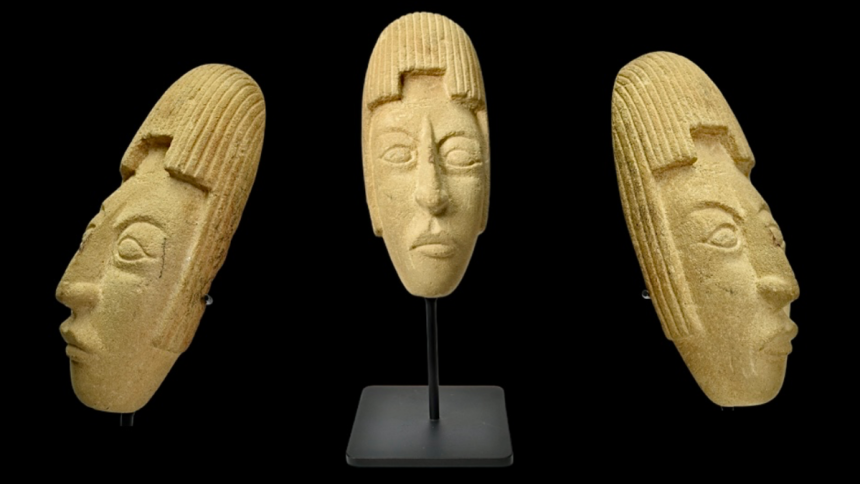Pre-Columbian stone objects are some of the most enduring and compelling artifacts from ancient America. These creations range from delicately crafted personal items like masks and figurines to monumental sculptures that defined political and religious power. Stone’s durability has allowed these objects to survive millennia, offering modern audiences a glimpse into the lives, beliefs, and artistry of the diverse civilizations that produced them.
This article explores the materials, techniques, cultural significance, and ongoing influence of Pre-Columbian stone artifacts, emphasizing their artistic and historical value.
1. The Foundations: Material Mastery and Craftsmanship
Pre-Columbian artisans displayed exceptional skill in using stone, a medium chosen for its availability and symbolic and functional qualities. Jadeite, basalt, serpentine, and obsidian were highly prized, each with unique properties and spiritual associations.
Key Materials:
• Jadeite: Renowned for its toughness and brilliant green hue, jadeite was associated with fertility, life, and the divine. It was often used for ceremonial masks and ornaments.
• Basalt: A dense volcanic stone, basalt was the material of choice for large sculptures like the Olmec colossal heads.
• Obsidian: Valued for its sharpness and reflective surface, obsidian was both a practical material for tools and a medium for ceremonial objects.
Techniques:
Crafting stone objects required sophisticated methods:
• Carving and Abrasion: Stones were shaped using harder materials, often requiring immense patience and precision.
• Polishing: Objects were often finished to a high sheen, enhancing their visual and tactile appeal.
• Etching and Drilling: Artisans used sand and tubular drills to create detailed carvings and suspension holes.
These labor-intensive techniques underscore the significance of these objects, which were often reserved for elite or sacred contexts.
2. Masks: Gateways to the Spiritual World
Stone masks are among the most iconic pre-Columbian artifacts. They served roles beyond adornment. They were often used in rituals to embody divine forces or commemorate the deceased.
Olmec Masks
The Olmec civilization considered the “mother culture” of Mesoamerica, created masks with serene, human-like features. Crafted from jadeite or serpentine, these masks symbolized power and transformation, possibly used in elite burial contexts.
Teotihuacan Masks
In contrast, masks from Teotihuacan, with their geometric features and polished surfaces, were likely affixed to effigies rather than worn. These masks were central to the city’s rich ceremonial life, often depicting deities or abstract beauty ideals.
3. Figurines: Intimate Expressions of Belief
Small stone figurines, often depicting humans, animals, or hybrid forms, were integral to daily and ceremonial life.
Mezcala Sculptures
Minimalist greenstone figures from the Mezcala culture of Guerrero are celebrated for their abstract elegance. Though centuries old, these objects bear a striking resemblance to modern art, emphasizing timeless aesthetic principles.
Maya Figurines
The Maya crafted highly detailed figurines portraying gods, rulers, and ceremonial dancers. These were often included in burial contexts, serving as intermediaries between the living and the dead.
4. Monumental Sculptures: Celebrating Power and Divinity
Pre-Columbian civilizations excelled in creating large-scale stone works that conveyed political authority and spiritual significance.
Olmec Colossal Heads
Weighing several tons and measuring over 10 feet in height, the colossal heads of the Olmec are marvels of engineering and artistry. Believed to represent rulers, their creation required immense resources and coordination, reflecting the centralization of Olmec power.
Aztec Sun Stone
One of the most famous Aztec artifacts, the Sun Stone, combines intricate carvings with cosmological significance. This monolithic piece was likely used as a calendar and a ritual object, underscoring the Aztec focus on the cyclical nature of time.
5. Regional Variations and Symbolism
Stone artifacts reflect the diversity of pre-Columbian civilizations, with each region contributing unique styles and iconography.
Mesoamerican Styles
• Zapotec Tomb Sculptures: Intricately carved figures placed in tombs to honor the deceased.
• Mixtec Reliefs: Detailed carvings depicting genealogical records and religious imagery.
Andean Stonework
In the Andes, the Inca were renowned for their seamless stone masonry, exemplified by sites like Machu Picchu. Portable stone idols, or huacas, held sacred significance and were often associated with specific locations.
6. Modern Legacy
Pre-Columbian stone objects continue to influence art, design,
and scholarship in the modern era. Their enduring beauty, combined with the cultural and historical narratives they represent, ensures their relevance to contemporary audiences.
Influence on Art
Many modern artists, including Surrealist and Abstract Expressionist movement members, have drawn inspiration from pre-Columbian stonework. These ancient artifacts’ bold forms, intricate carvings, and spiritual resonance have informed modern aesthetics, bridging the past with contemporary creativity.
Interior Design and Collecting
Pre-Columbian stone objects have found a place in high-end interior design, where their timeless appeal complements traditional and modern settings. Collectors treasure these artifacts for their craftsmanship and cultural depth, often incorporating them into personal and public displays.
Ethical Collecting
As interest in pre-Columbian artifacts grows, so do concerns about provenance and ethical acquisition. Responsible collectors emphasize the importance of acquiring items through legitimate channels, ensuring that cultural heritage is preserved and respected.
7. Preserving a Legacy
Efforts to conserve pre-Columbian stone art are essential to safeguarding their legacy for future generations. Archaeological sites, museums, and private collectors are crucial in protecting these treasures from natural erosion, looting, and improper handling.
Challenges in Preservation
• Environmental Factors: Stone objects face gradual degradation due to exposure to weather and environmental pollutants.
• Illegal Trade: Looting remains a significant issue, depriving artifacts of archaeological context and cultural significance.
Solutions
Conservation initiatives focus on stabilizing artifacts, documenting their provenance, and educating the public about their importance. Collaborative efforts between governments, museums, scholars and responsible collectors aim to protect these cultural treasures while fostering appreciation for their historical value.
Conclusion
Pre-Columbian stone objects are not merely relics of the past—they are testaments to the ingenuity, artistry, and spiritual depth of the ancient civilizations that created them. These works, from small figurines to monumental sculptures, capture a world where art, culture, and belief are deeply intertwined.
In their timeless beauty and profound symbolism, Pre-Columbian stone artifacts continue to connect us to the distant past, offering insights into the universal human drive to create and preserve meaning. By honoring these objects and their origins, we celebrate ancient artistry and ensure their stories endure for generations.
For a deeper dive into Pre-Columbian art and its timeless beauty, visit Galeria Contici
Lynn Martelli is an editor at Readability. She received her MFA in Creative Writing from Antioch University and has worked as an editor for over 10 years. Lynn has edited a wide variety of books, including fiction, non-fiction, memoirs, and more. In her free time, Lynn enjoys reading, writing, and spending time with her family and friends.















